Composed in 1923 and published by Carl Fischer the following year, the Enfantines were written for the composer's daughters Suzanne and Lucienne for use in their home music study. A major pedagogical contribution to students of the piano, these ten pieces, each a miniature of tasteful expression, provide the novice with an aural experience not customarily encountered, owing to the combined modal-tonal flavor. Additionally, they offer a challenge with their always musical technical problems.
The Enfantines date from the period in which Bloch was serving as director of the Cleveland Institute of Music. Eight of the selections in this opus are dedicated to Cleveland piano teachers; two are dedicated to the Bloch daughters (Lullaby to Suzanne and With Mother to Lucienne). The capsule commentaries below will convey some of the features of the individual pieces.
Lullaby, a study in legato playing, requires the change of fingers on a held note (first finger replaced by fifth) and the holding of a long pedal on one finger while the other fingers of the same hand are playing a melody above it.
The two-note slur, the distinction between various types of accent mark, portato playing, and frequent tempo changes are features of The Joyous Party. With Mother, a study in phrasing, requires a legato style and also a smooth change of fingers on a held note. Elves deals with the problems of dividing evenly arpeggiated figures between the hands, and with bringing out a left-hand melody below continuous movement in the right hand.
The alternating meters of Joyous March and the rapid finger changes on the same notes (single notes and chords) make this a particularly effective piece. There is also opportunity here for contrasting legato and staccato touches. Melody requires the use of the existing qualities of the pedal, and it provides for the simultaneous employment of different touches (e.g., left-hand legato passages and right-hand half-staccato beneath two-note chords). Also prominent are long crescendos and decrescendos.
Syncopated rhythmic patterns and simultaneous playing of two different types of rhythm (e.g.,  in the right hand against
in the right hand against  in the left hand) are the principal aspects of the Pastorale. Rainy Day offers a fine study in phrasing (
in the left hand) are the principal aspects of the Pastorale. Rainy Day offers a fine study in phrasing ( ), the playing of a left-hand melody against a reiterated figure in the right hand, the interchange of melody and accompaniment between hands, and the holding of a pedal while other fingers of the same hand are playing. The piece succeeds also in its descriptive qualities.
), the playing of a left-hand melody against a reiterated figure in the right hand, the interchange of melody and accompaniment between hands, and the holding of a pedal while other fingers of the same hand are playing. The piece succeeds also in its descriptive qualities.
Teasing emphasizes the performance of dotted rhythms, the contrasting of different types of accent marks, portato playing, off-beat accents, and the rendering of a legato passage in one hand while the other hand is playing an assortment of different touches. Dream features legato playing in both hands and a variety of phrasings; it also requires the player to sustain a single mood for the entire composition. Sparse but effective use of the pedal and cross-handed playing are also important here.
Lucienne Bloch made the original drawings which accompany each piece in the Carl Fischer edition of the Enfantines. They are a helpful adjunct to the creation of the proper "feeling" on the part of the student.
Lullaby begins moderato in  , with an Aeolian melody notable for the omission of the third (see Ex. 1, from page 4, stave 1, measures 1-2 of the Fischer edition; all further references are to this edition).
, with an Aeolian melody notable for the omission of the third (see Ex. 1, from page 4, stave 1, measures 1-2 of the Fischer edition; all further references are to this edition).
Ex. 1.
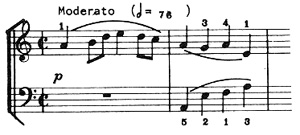
At the espressivo the theme, in the dominant (left hand), is reiterated partially and leads to a series of half-note cadences (p. 4, stave 3, measures 3-4), which prepare for an important whole-note cadence (IV-I) in C Major, with a fermata. At the a tempo, a motive based on one heard earlier at the espressivo (right hand) enters in the left hand, unfolds in both hands, cadences on a G Major chord and leads to a statement of the opening theme in the dominant over an A pedal (Ex. 2).
Ex. 2.
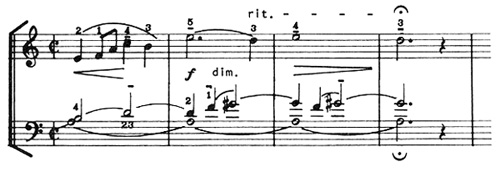
The only appearance of a G-sharp occurs during the elongated cadence, which culminates in a chord producing a major seventh and a diminished fifth. The last five measures of the piece bring back the theme in its original Aeolian setting with the suggestion of a final plagal cadence.
As a change of pace from the serious tone of the Lullaby, Joyous Party commences allegro giocoso in  with an E Minor theme comprising a series of short slurs (Ex. 3);
with an E Minor theme comprising a series of short slurs (Ex. 3);
Ex. 3.

it is not until the appearance of the C-sharp in the left hand at the poco rallentando that an allusion to the Dorian mode is manifest, but at this point preparation is made for a subsidiary theme which combines elements of both D Major and B Minor (Ex. 4).
Ex. 4.
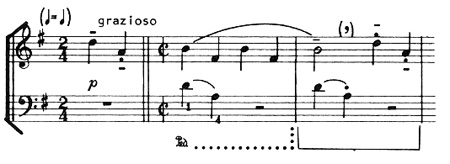
During the sequential course of this material, a series of 6-5 appoggiaturas become prominent (see p. 6, stave 3, measure 6); following a brief cadence in D Minor, a descending sequence of short cadences in E Major, D Major, C Major, and B Minor precede a return to the opening material, now in pure A Minor. At the poco accelerando, the secondary material re-enters in G Major/E Minor and after a dramatic pause, the piece ends on a G Major chord.
With Mother (Andantino,  ) may be a nostalgic personal reminiscence. The opening espressivo melody, an ambivalent mixture of G Major and E Minor, is dependent on the left hand for its stability (Ex. 5; in the Fischer edition page 8, stave 1, measures 1-4).
) may be a nostalgic personal reminiscence. The opening espressivo melody, an ambivalent mixture of G Major and E Minor, is dependent on the left hand for its stability (Ex. 5; in the Fischer edition page 8, stave 1, measures 1-4).
Ex. 5.
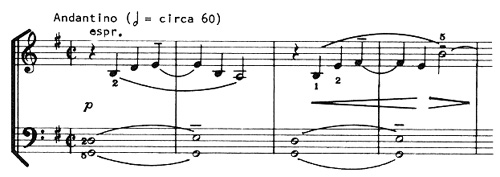
As it unfolds, an expansion of fourths and fifths in the left hand (see p. 8, stave 3, measures 1-3) becomes a prominent feature just before a new theme enters at the dolce. Here, amid considerable close passage work in the inner voice, a broad scalar melody in the top voice of the right hand is framed against rising fourths in the left hand until, at the a tempo, a variant of the opening theme enters marcato in the right hand over a D pedal, during which sequential material in ascending pairs of melodic fourths become perceptible in the melodic line (Ex. 6).
Ex. 6.
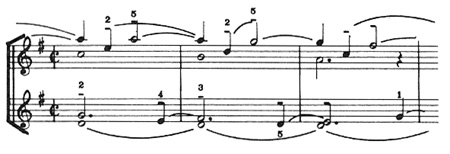
The section closes with a C-sharp diminished-seventh chord, a C Major ninth chord, and a D Major seventh chord. At tempo I the main theme returns in its original guise, but before long the G in the bass becomes an extended pedal point, above which a series of three perfect fifths and one diminished fifth are noticeable in the melody (Ex. 7).
Ex. 7.

With the arrival of the molto espressivo e tranquillo, featuring a series of ninth chords, the piece draws to a pianissimo conclusion, and with it another of the main theme; the ambivalent tonality is cleared up only in the final G Major chord.
Elves is dominated by swirling arpeggio figures, beginning on D and working down to A (first note of the left hand at the opening of the first five measures). This material (Ex. 8; p. 10, stave 2, measure 1) gives way to a thrice-repeated three-note melodic fragment in the left hand in quarter notes, above which the three groups of three eighth notes, a carry-over from the arpeggio figures, continues to convey continuous movement (Ex. 9).
Ex. 8.
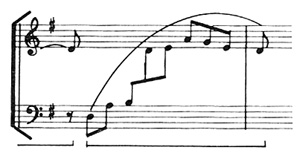
Ex. 9.

The top voice of the right hand then presents, in rhythm a melody comprising a descending G Major scale, as both hands resume the arpeggio figurations; a group of short phrases based on the scalar material ensues with some chromatic alterations suggestive of E Minor/Dorian. The D-sharp at the poco ritard, approached by G, leads to a five-measure section in which the left hand sequential pattern is arranged so as to create accents in different parts of the melodic line during each presentation (Ex. 10; p. 12, stave 1, measures 1-3). This descending pattern, followed by silence, prepares for a return in G Major to the opening theme.
Ex. 10.

Joyous March, in G Major, makes use of dual meter signatures,  and 3/4, owing to the continually alternating rhythmic structure. The staccato melody, constructed largely in complete triads, contains a heavily accented seventh chord on the last beat of the measure (Ex. 11; p. 13, stave 1, measures 1-2).
and 3/4, owing to the continually alternating rhythmic structure. The staccato melody, constructed largely in complete triads, contains a heavily accented seventh chord on the last beat of the measure (Ex. 11; p. 13, stave 1, measures 1-2).
Ex. 11.
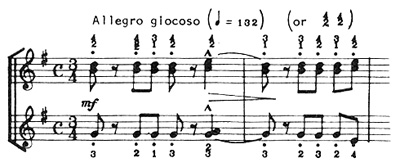
This basic material continues, touching on the mediant and submediant of the principal key, until a V7—I cadence in G Major occurs (measures 8-9); following a brief pause the main theme returns, but it now features added minor seconds (Ex. 12).
Ex. 12.
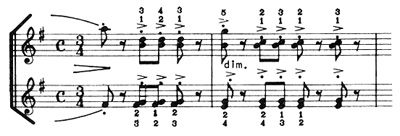
A pesante prepares for a new section poco meno vivo, in which the theme's character is transformed—it is dolce, contains single notes rather than full triads, and has more legato passages—and it is heard above a C-G bass for five measures, but then goes through a series of rapid key transformations, notably E Minor, and B Minor. A long series of repeated Ds at the a tempo introduces the main theme in its original state in the right hand, but on this occasion over a bass comprising, alternately, four and three groups of two-note slurs (Ex. 13).
Ex. 13.

A short and soft coda in C Major brings the piece to a close, but with a surprising forte on the final G Major chord.
Melody emphasizes the sequential treatment of a single melody, moderato and in common time. The theme, a left hand espressivo subject (Ex. 14; p. 16, stave 1, measures 1-2) is presented three times, each appearance a third lower than the preceding entry; the third occurrence is altered slightly, serving as a transitional statement to a new set of thrice-repeated entries of the theme, which is now in the right hand above a chordal left-hand accompaniment.
Ex. 14.
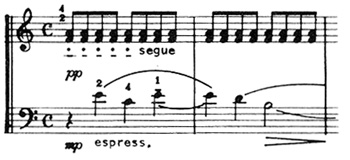
Full triads and some seventh chords are the prevailing harmonic textures. Upon the succeeding sequence of three entries, each still below the preceding one, the melody is adorned somewhat (Ex. 15) while the bass is given a measure-long pedal for four measures comprising a descending scale passage, G down to D.
Ex. 15.
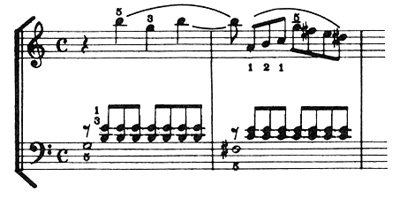
A brief developmental section with melodic strands exchanged between the hands leads to a closing statement in which the theme's opening three notes, and then two notes, prepare for the final F-seventh chord. The key signature of no sharps or flats, and the importance of A Minor triads combined with F Major, suggests with the frequent B-naturals an Aeolian/Lydian modality, albeit with chromatic inflections and excursions to other keys.
Pastorale opens with a jaunty tune in F Major in 6/8 meter in the right hand above an F pedal (Ex. 16; page 20, stave 1, measures 1-2);
Ex. 16.
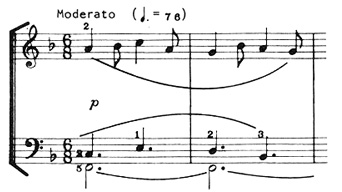
this melody is repeated slightly embellished at the a tempo above a more active bass, and gives way at the mp espressivo to a thematic variant (Ex. 17) in A Major.
Ex. 17.
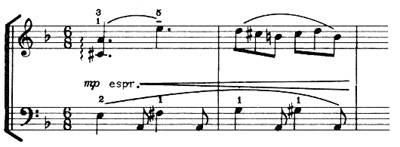
The theme returns at the pp dolcissimo, but with the B-flat replaced by a B-natural, and the F pedal changed to arpeggiated D Minor triads in the rhythm noted above—in short, a Dorian construction; with the poco animando there begins a series of pedals with the syncopated rhythm pattern  , as the right hand presents the theme in a condensed two-note-chord fashion. The theme returns briefly, makes two false starts, and finally is heard in its original state in F Major, closing with a brief coda dolcissimo above the now familiar rhythm.
, as the right hand presents the theme in a condensed two-note-chord fashion. The theme returns briefly, makes two false starts, and finally is heard in its original state in F Major, closing with a brief coda dolcissimo above the now familiar rhythm.
Rainy Day is characterized from the outset by a reiterated ostinato in the right hand descriptive of the pattern of rain drops; the tonality is D Minor and the meter signature is 3/4. After two measures the left hand, in the treble clef, renders the melody (Ex. 18; p. 23, stave 1, measures 1-3).
Ex. 18.

The theme is expanded somewhat at the poco crescendo, as the right hand enlarges its repetitious  pattern, suggesting A Major, but closing the first section of the piece in the tonic key (p. 24, stave 3, measure 4). The theme re-emerges in the right hand while the left hand takes up the "rain" pattern over a D pedal in the bass. As A Major is reached again, an E pedal is given to the tenor as reinforcement of the dominant key, while the "rain" pattern is heard with a D pedal in the bass. Eight measures before the composition closes, the right hand again offers the "rain" motive, while the theme, in open fifths, is heard in the left hand. The final chord is, characteristically, a dominant without the third.
pattern, suggesting A Major, but closing the first section of the piece in the tonic key (p. 24, stave 3, measure 4). The theme re-emerges in the right hand while the left hand takes up the "rain" pattern over a D pedal in the bass. As A Major is reached again, an E pedal is given to the tenor as reinforcement of the dominant key, while the "rain" pattern is heard with a D pedal in the bass. Eight measures before the composition closes, the right hand again offers the "rain" motive, while the theme, in open fifths, is heard in the left hand. The final chord is, characteristically, a dominant without the third.
A light-hearted fun piece, Teasing (allegro vivo, G Major, common time) is based on a tune comprised of two descending fourths (a minor seventh) interrupted by sixteenth rests (Ex. 19; p. 26, stave 1, measures 1- 2).
Ex. 19.

At the conclusion of this material, a series of chords with added seconds (accelerando e crescendo) enters with accents on beats two and four (Ex. 20),
Ex. 20.

but gives way at the a tempo to a return to the main theme; "tearfully," subsidiary material based on the same rhythmic pattern is presented with a variety of chromatically inflected chords in the right hand, culminating at the poco rit., in a D Minor chord to E-seventh chord, followed by a chord made up of G-sharp, B-flat, and F. The opening theme returns, seeming to combine B Minor (natural minor) with G Major. At the fortissimo the theme, above a G Major triad, is rendered in a descending spiral, leading to a return of the chords with added seconds cited earlier, accelerando, and a final G Major chord.
A mood picture, Dream (G Minor, 9/8 meter) opens pianissimo with a plaintive melody featuring a raised sixth degree (Dorian) above a reiterated series of G Minor triads (Ex. 21; p. 29, stave 1, measure 2) but, as the melody expands, it appears briefly and partially in the left hand also.
Ex. 21.
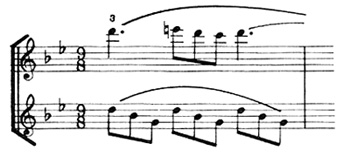
When the right hand assumes the eighth-note figures, a left hand melody enters espressivo (Ex. 22) and leads to the dominant key, where it is further expanded.
Ex. 22.

At the a tempo the opening melody returns in the dominant of F-sharp Minor (Ex. 23); this seemingly remote tonality was prepared earlier (stave 3), where both D-flat Major and C-sharp minor triads were played in the right hand.
Ex. 23.
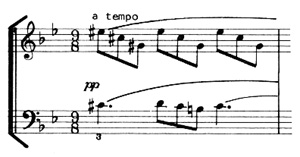
A brief section in B-flat Major (beginning stave 5, measure 3) prepares for a concluding statement in G Major, featuring cross-handed playing, use of pedal, and a brief suggestion of G Minor.
APPENDIX
The Dedicatees of the Individual Pieces in the Enfantines
| Lullaby | SuzanneBloch |
| The Joyous Party | Mrs. B.F. Kortheuer |
| With Mother | Lucienne Bloch |
| Elves | Ruth Edwards |
| Joyous March | Beryl Rubinstein |
| Melody | Dorothy Price |
| Pastorale | Eleanor Foster |
| Rainy Day | Nathan Pryor |
| Teasing | M. Edith Martin |
| Dream | Anita Frank |


